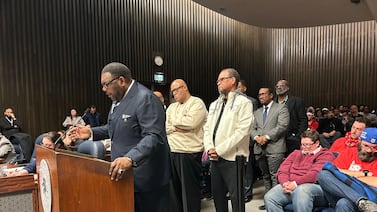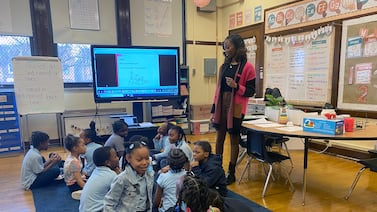Sign up for Chalkbeat Colorado’s free daily newsletter to get the latest reporting from us, plus curated news from other Colorado outlets, delivered to your inbox.
Education funding dominated the discussion at Chalkbeat Colorado’s annual Legislative Preview event Monday, as a panel of state lawmakers grappled with how Colorado will fund K-12 schools and public colleges in the face of looming budget cuts.
“We are in a very, very tight budget year,” said Sen. Barbara Kirkmeyer, a Weld County Republican who sits on the powerful Joint Budget Committee. “We have to cut.”
The 2025 legislative session starts Wednesday.
State lawmakers said they must cut between $700 million and $1 billion from Colorado’s $16 billion general fund budget to balance the state’s finances. Funding for K-12 schools accounts for about a third of that $16 billion, making it one of Colorado’s largest expenses alongside Medicaid.
Just last year state lawmakers voted to fully fund Colorado schools by eliminating a funding mechanism that withheld money from K-12 education to pay for other state budget priorities. All of the lawmakers on Chalkbeat’s panel said it is a top priority to ensure that the mechanism, known as the budget stabilization factor, doesn’t come back.
The five state lawmakers who joined us for the event were:
- Sen. Jeff Bridges, an Arvada Democrat and chair of the Joint Budget Committee.
- Sen. Barbara Kirkmeyer, a Weld County Republican who sits on the JBC.
- House Assistant Majority Leader Jennifer Bacon, a Denver Democrat.
- House Majority Co-Whip Matthew Martinez, a Monte Vista Democrat.
- Rep. Lori Garcia Sander, a Republican from Eaton who was elected in November.
The event was moderated by Chalkbeat reporter Jason Gonzales and William Navarrete Moreno, a student at the University of Colorado Denver who is studying public health and is active with Young Invincibles, an organization that amplifies the voices of young adults.
A full video of the event is posted below. Here are some excerpts from the discussion, which also touched on child care, higher education, teacher recruitment and retention, and more. The excerpts have been edited for length and clarity.
State lawmakers may have to make deep cuts to Colorado’s budget this session. How might the cuts affect education? Which programs might end? What do you want to keep?
Kirkmeyer: With regard to cuts in the Department of Education, there’s about $81 million worth of grant programs … that don’t appear to be that equitable. In fact, the Department of Education gave us a survey that showed that … they’re going to a limited number of school districts.
Martinez: For higher education funding, and for our rural institutions as well, too, they deal with a lot of different scenarios. They’re on a different playing field. And so being able to really work toward preserving their funding as well, too, because they’re already operating on a shoestring budget and any cuts are going to be into the bone.
Gov. Jared Polis has proposed changing the way school districts are funded by basing their funding on current enrollment versus a multiyear average. That proposal could mean less money for districts with declining enrollment. Does the JBC support that?
Kirkmeyer: I don’t support the governor’s request. He wants to get rid of — I call them ghost kids. I know y’all call them phantom kids. … The JBC isn’t going to be making that decision — at least, not from my perspective. I won’t be supporting a bill that changes that. It needs to go through the school finance formula act … and it needs to have adequate debate on the floor and everybody needs to have the opportunity [to weigh in], including all the stakeholders.
Bridges: If we have to choose between adequately funding the students we have or funding districts for students they don’t have, I’m going to side with the students that actually exist every single time. … The phantom student piece is: Do we average attendance for schools over a five-year period or a four-year or a three-year or a two-year period? Or do we just fund the students they have right now? My guess is that we’ll end up somewhere along that spectrum, but no other state in the country funds districts with a rolling average of five years.
With the Trump administration’s plan to roll back policies that once barred ICE raids at schools, many undocumented students and families now fear attending school. Will you support state-level policies to prohibit immigration enforcement on school grounds?
Bacon: We don’t necessarily have anything on the books right now for sanctuary schools. However, we have passed laws and we do expect that those who have sworn to uphold those laws will uphold Colorado laws. And right now, our laws say we do not share data. We do not engage in immigration work that is reserved for the federal government. And therefore, we will expect that those laws and rules are upheld and that we do it in the interest of providing that confidence and safety for our young people, regardless of their immigration status.
Garcia Sander: So ultimately, I believe we just need to follow the laws that are in place, right? A lot of my career has been working with multilingual learners. I’ve been an [English language development] teacher … Rarely will it come up where I’ve had a student either in elementary, middle, or high school that has concerns, but there’s a culture in the districts where I’ve worked where we reassure students: Your job is to come here to school. We’re going to teach you no matter what. We support you no matter what. We’ll get you what you need no matter what. Let the grownups take care of the grownup stuff, and we’re going to take care of you here at school.
Colorado doesn’t have enough money for its program that provides free school meals to all students. An advisory group suggested ways to cut costs. How are you going to continue to fund this program? Will you have to cut it back?
Bridges: The referendum that went to the voters of Colorado had a lot of extraneous things in it, and they were all important and wonderful and great. And we don’t get nice-to-haves this year. … So all that other stuff [in the referendum], I don’t think that’s going to get funded. … Food for kids was the core of that question to voters. … And so we want to make sure that every kid in the state has that opportunity and that every kid is well-fed.
Kirkmeyer: There are some kids that are getting these meals that, you know, their parents can afford to pay for the meal themselves and we can make the program work for everybody else. … They actually need to come back — the Healthy School Meals [for All] folks and the Department of Education — with some ideas about where we can actually fund [the free meals program] within the ballot initiative that they passed.
What can the state legislature do to help attract and retain teachers?
Garcia Sander: I work in a rural school district and we have a huge challenge of attracting and retaining teachers. … We have started to source our high school students actually as pre-service paraprofessionals and thinking about, How can we get them enrolled [in teacher preparation programs]? Right now we’ve got a student teacher, she’s 21, and right out of high school, we hired her as a paraprofessional. And in her second year she was … long-term substitute teaching Spanish classes in our high school because we didn’t have a Spanish teacher. … And so we need to do what we can to create our own pipelines in districts.
Bacon: I did teacher recruitment for a long time, especially with teachers of color. And low-income people are more likely, even though they have [federal] Pell [grants] and whatnot, to borrow for [college] for living expenses. And to say that you need to come back out of school with $80,000 worth of debt and you make $35,000 a year is an actual challenge. And so we do need to think about our [state] revenues. … I got a [TABOR] refund of $8. For the low, low cost of $8, I’d rather put that back in the pot to have a music teacher.
One of the biggest expenses for families, particularly young families, is child care. What opportunities do you see to both increase the supply of high-quality child care, especially for infants and toddlers, while also lowering the cost?
Martinez: As the state of Colorado, the neighbors and taxpayers, we do need to talk about our revenues and how the state funds things, as well as what is the reality of living. … We have a state where people vote for the things that they want, like food for kids, right? That was a proposition. But there was also a proposition to spend $350 million on law enforcement. And so we have a world where our neighbors are talking about what we want and what we need, and they vote for it, but we’re not also talking about actually how much money we have and how do we prioritize things. … This $700 million structural deficit is the time for us to say — maybe this is rock bottom, but we do need to hear from people on what it is we need to prioritize.
Watch the full video below.
This story has been updated to clarify that $16 billion is the amount of Colorado’s general fund budget, not its total budget.
Melanie Asmar is the bureau chief for Chalkbeat Colorado. Contact Melanie at masmar@chalkbeat.org.





